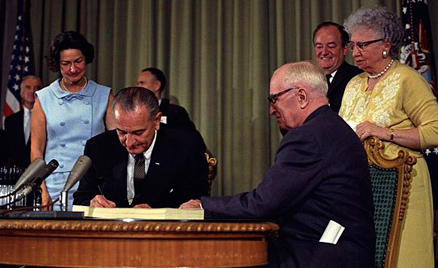Repeating LBJ’s mistakes in 2016
 Lyndon Johnson Library
Lyndon Johnson Library
A scuffle last week over whether independent Vermont Sen. Bernie Sanders adequately supported former Secretary of State Hillary Clinton’s 1993-1994 health care reform efforts highlighted how the question of moving beyond the Affordable Care Act has emerged as a defining difference between the two candidates. The most recent dispute seems to have been resolved. But the larger issue remains. Just as we saw with President Lyndon B. Johnson's fight for Medicare in 1965, both candidates are presenting plans that while politically expedient, fail to adequately control costs.
We cannot afford to have history repeat itself in this regard. Given health care’s impact on both federal and state budgets, cost containment has to be at the heart of the conversation about post-Affordable Care Act reform.
In the decades since President Harry Truman’s fight for universal coverage, the Democratic Party has seen two major health care success stories: the passage of Medicare and Medicaid in 1965 and the signing of the Affordable Care Act in 2009. While the health care law undoubtedly factors heavily into the conversation, Clinton and Sanders cannot overlook lessons that can be gleaned from Johnson’s earlier breakthrough.
The passage of Medicare and Medicaid represents one of the most significant accomplishments of Johnson’s Great Society. Medicare in particular has done more than any other federal policy to lift seniors out of poverty and ensure dignity and a modicum of comfort in old age.
But the program also created serious long-term budgetary challenges. Johnson and his allies made a political choice to maintain the existing, fee-for-service payment structure of American medicine. Fee-for-service creates a core financial incentive for providers to always do more: more tests, more procedures, and more hospitalization, which leads to more payments and more revenues for providers.
Following years of bruising legislative battles with the primary physicians lobby, the American Medical Association, the president and his allies made this decision to avoid further conflict with the doctors. They agreed that Medicare would leave the determination of reasonable charges up to physicians in conjunction with insurance companies. (U.S. Secretary of Health, Education, and Welfare Wilbur Cohen explained it to Johnson in a recorded 1965 phone call following the passage of the legislation.) Hospitals received a similar degree of pricing deference. Over time, this latitude contributed to the excessive rate of cost inflation in the wider health care system.
Although some limits have been imposed on such payments (such as Medicare’s Hospital Value-Based Purchasing program), the core incentives to do more remain in place. The result is that Medicare and Medicaid are expensive because they are intertwined with the larger U.S. health care system and its incentives to spend. The lesson is simple: unless payment systems for providers are addressed, limiting private insurance alone will not resolve the cost problem.
Present trends in the cost of health care underscore why it’s so important that we get this right. Health care spending in the United States rose 5.3 percent in 2014 to $3 trillion, or $9,523 per person. Federal and state governments covered about 60 percent of that. Programs like Medicare and Medicaid will more than double between 2014 and 2025, growing from $925 billion to $1.9 trillion, or 27 percent of all federal spending.
Which brings us back to the debate raging today on the Democratic campaign trail. Sanders has proposed a single-payer system that grants “Medicare-for-all.” Clinton prefers a state-based “public option” that would compete with the private health plans currently offered on the Affordable Care Act insurance exchanges. Both plans focus on expanding coverage. Neither directly addresses the rate of cost escalation.
They both assume that the issue can be addressed via the inefficiencies of private insurance. Essentially, do away with private health insurance (or at least constrain its role), and the economies of scale and bargaining power of public financing plans will resolve the fiscal crisis.
Unfortunately, the problem is not that simple. Savings on the insurance side will not do enough on their own. A real solution would drive at the cost structures embedded in the delivery system, namely hospitals and physicians. The difficulty is that, just as was the case with Johnson, it’s easier to promote coverage expansions than politically unsavory cost offsets.
This is especially true given where the debate is now. Insurance companies are an easy stalking horse, but physicians and hospitals are far more sympathetic to voters. Yet however difficult, meaningful reform requires pushing back on the payments these providers receive.
Disputes over 1993 aside, this is the dilemma that both Sanders and Clinton are avoiding. It is imperative that at some point reformers turn and tackle this issue head on, regardless of the near-term fallout. Unless they do, costs will keep going up, and presidential candidates will keep returning to this issue.
Tony Lucadamo is the lead policy analyst at the University of Virginia’s Miller Center. You can follow him on Twitter: @tonylucadamo. Guian McKee is an associate professor of public policy at the University of Virginia’s Miller Center, and a fellow at UVA’s Center for Health Policy. You can follow him on Twitter:@guian_mckee.